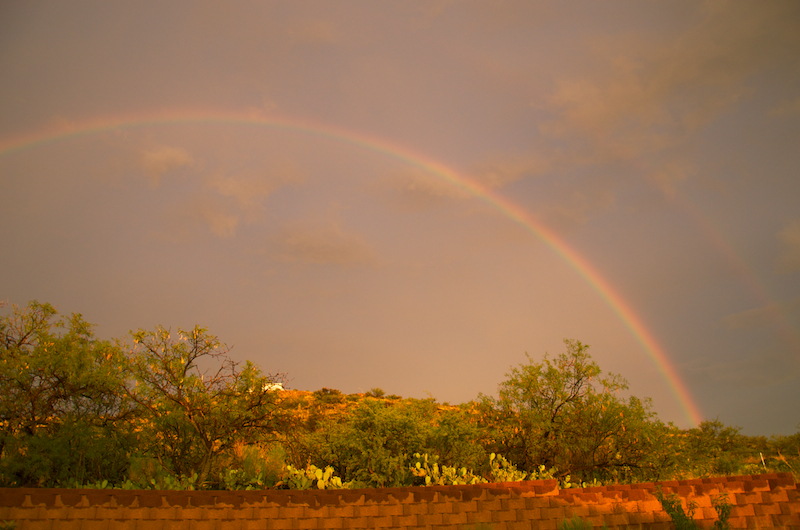
Finally, Some Observing Again
Posted: 18 July 2012
Monsoon storm clouds arrived on Saturday, 23 June 2012, and continued through Thursday, 28 June. No rain here though, just clouds and thunder, until Wednesday afternoon, 27 June, when we had 0.68" of rain in a little over one hour. Thursday, 28 June, the sky cleared until late afternoon, when a monsoon storm appeared in the south. I thought about getting in some limited observing, but I had to get ready for a trip, and so didn't open the observatory. During the trip, monsoon storms brought about 2" of rain. When I returned from the trip on Sunday, 15 July, monsoon storms were still a threat. I captured this double rainbow as sunset approached on Sunday:

I finally opened the observatory again on Tuesday, 17 July 2012, at 1902 MST, 95°F. The sky was mostly clear but there were some high thin clouds visible. I had planned to do some DSO astrophotography, but with the clouds I decided to just do some observing.
At 1919 MST, I powered on the 8" LX200-ACF telescope for the first time in almost three weeks. At 1922 MST, viewed Saturn at 77X and 133X. At 1945 MST, viewed Mars, 133X. Seeing was not very good and no details were visible. Went back to Saturn, 133X. Titan and Cassini Division were visible. At 1953 MST, picked up the moons Dione and Rhea. At 1956 MST, the moon Tethys appeared.
I slewed to the NGC4424 galaxy at 2001 MST to check on the status of supernova SN2012cg once twilight ended. At 2025 MST, this cricket came to visit:

Finally at 2039 MST, I could just see the galaxy at 77X using averted vision. The sky was still a little too bright for good viewing and I could not make a positive ID on the supernova. By 2044 MST, I could occasionally get a glimpse of what was likely the supernova using averted vision. At 2048 MST, the galaxy was easier to see; the supernova was fainter than I remembered from my previous viewing in May 2012. The high thin clouds and the low altitude of the galaxy contributed to poor viewing.
At 2102 MST, I began viewing some other DSOs at 77X. Observed M102 (galaxy), NGC6939 (open cluster) and the nearby NGC6946 (galaxy), and NGC6804 (planetary nebula). At 133X, the planetary nebula looked very nice. I have added these DSOs to my astrophotography list and will image them on a future session. I then viewed M57, the Ring Nebula, 133X and 77X. Always a nice object to view.
Due to the clouds, I decided to end this session. As I was closing the observatory I saw a Kissing Bug. I was surprised by this as I had assumed the Kissing Bug season was over. Bug was exterminated.
Closed the observatory at 2127 MST, 77°F.
Comments are welcome; use the Comments section below, or you can Email Me. Thanks.
Go to the previous report.
Return to the Cassiopeia Observatory Welcome Page.